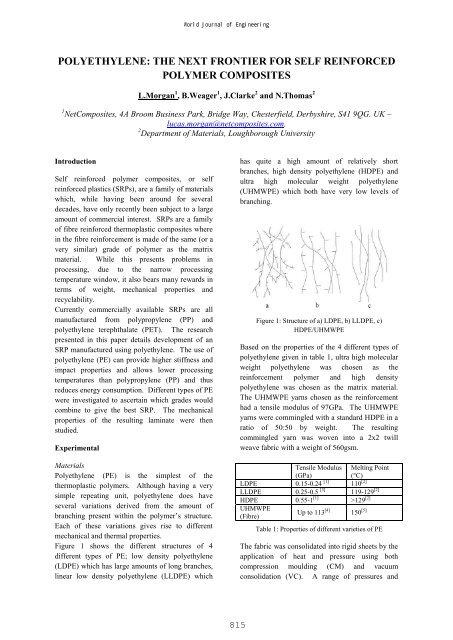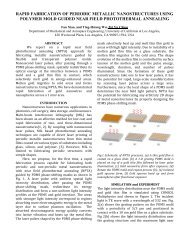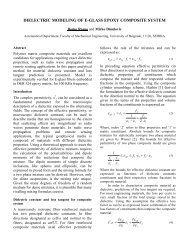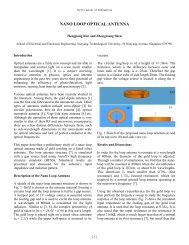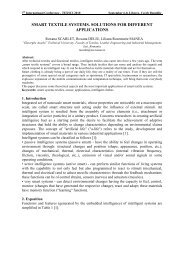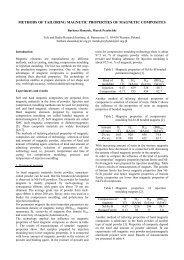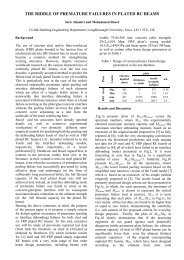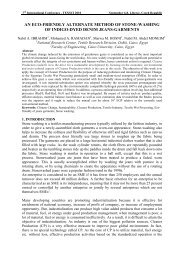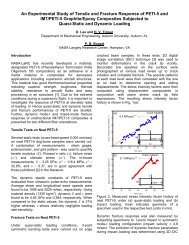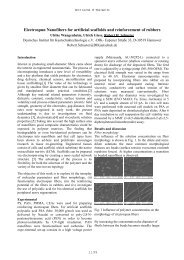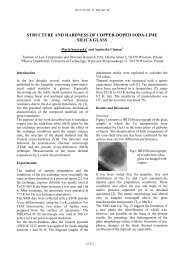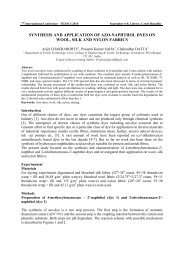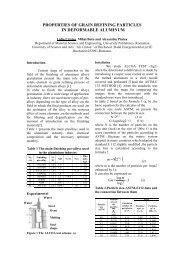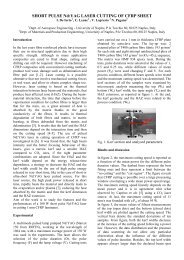polyethylene: the next frontier for self reinforced polymer composites
polyethylene: the next frontier for self reinforced polymer composites
polyethylene: the next frontier for self reinforced polymer composites
You also want an ePaper? Increase the reach of your titles
YUMPU automatically turns print PDFs into web optimized ePapers that Google loves.
World Journal of Engineering<br />
POLYETHYLENE: THE NEXT FRONTIER FOR SELF REINFORCED<br />
POLYMER COMPOSITES<br />
L.Morgan 1 , B.Weager 1 , J.Clarke 2 and N.Thomas 2<br />
1 NetComposites, 4A Broom Business Park, Bridge Way, Chesterfield, Derbyshire, S41 9QG. UK –<br />
lucas.morgan@net<strong>composites</strong>.com.<br />
2 Department of Materials, Loughborough University<br />
Introduction<br />
Self rein<strong>for</strong>ced <strong>polymer</strong> <strong>composites</strong>, or <strong>self</strong><br />
rein<strong>for</strong>ced plastics (SRPs), are a family of materials<br />
which, while having been around <strong>for</strong> several<br />
decades, have only recently been subject to a large<br />
amount of commercial interest. SRPs are a family<br />
of fibre rein<strong>for</strong>ced <strong>the</strong>rmoplastic <strong>composites</strong> where<br />
in <strong>the</strong> fibre rein<strong>for</strong>cement is made of <strong>the</strong> same (or a<br />
very similar) grade of <strong>polymer</strong> as <strong>the</strong> matrix<br />
material. While this presents problems in<br />
processing, due to <strong>the</strong> narrow processing<br />
temperature window, it also bears many rewards in<br />
terms of weight, mechanical properties and<br />
recyclability.<br />
Currently commercially available SRPs are all<br />
manufactured from polypropylene (PP) and<br />
<strong>polyethylene</strong> terephthalate (PET). The research<br />
presented in this paper details development of an<br />
SRP manufactured using <strong>polyethylene</strong>. The use of<br />
<strong>polyethylene</strong> (PE) can provide higher stiffness and<br />
impact properties and allows lower processing<br />
temperatures than polypropylene (PP) and thus<br />
reduces energy consumption. Different types of PE<br />
were investigated to ascertain which grades would<br />
combine to give <strong>the</strong> best SRP. The mechanical<br />
properties of <strong>the</strong> resulting laminate were <strong>the</strong>n<br />
studied.<br />
Experimental<br />
Materials<br />
Polyethylene (PE) is <strong>the</strong> simplest of <strong>the</strong><br />
<strong>the</strong>rmoplastic <strong>polymer</strong>s. Although having a very<br />
simple repeating unit, <strong>polyethylene</strong> does have<br />
several variations derived from <strong>the</strong> amount of<br />
branching present within <strong>the</strong> <strong>polymer</strong>’s structure.<br />
Each of <strong>the</strong>se variations gives rise to different<br />
mechanical and <strong>the</strong>rmal properties.<br />
Figure 1 shows <strong>the</strong> different structures of 4<br />
different types of PE; low density <strong>polyethylene</strong><br />
(LDPE) which has large amounts of long branches,<br />
linear low density <strong>polyethylene</strong> (LLDPE) which<br />
has quite a high amount of relatively short<br />
branches, high density <strong>polyethylene</strong> (HDPE) and<br />
ultra high molecular weight <strong>polyethylene</strong><br />
(UHMWPE) which both have very low levels of<br />
branching.<br />
Figure 1: Structure of a) LDPE, b) LLDPE, c)<br />
HDPE/UHMWPE<br />
Based on <strong>the</strong> properties of <strong>the</strong> 4 different types of<br />
<strong>polyethylene</strong> given in table 1, ultra high molecular<br />
weight <strong>polyethylene</strong> was chosen as <strong>the</strong><br />
rein<strong>for</strong>cement <strong>polymer</strong> and high density<br />
<strong>polyethylene</strong> was chosen as <strong>the</strong> matrix material.<br />
The UHMWPE yarns chosen as <strong>the</strong> rein<strong>for</strong>cement<br />
had a tensile modulus of 97GPa. The UHMWPE<br />
yarns were commingled with a standard HDPE in a<br />
ratio of 50:50 by weight. The resulting<br />
commingled yarn was woven into a 2x2 twill<br />
weave fabric with a weight of 560gsm.<br />
Tensile Modulus<br />
(GPa)<br />
Melting Point<br />
(°C)<br />
LDPE 0.15-0.24 [1] 110 [2]<br />
LLDPE 0.25-0.5 [3] 119-129 [2]<br />
HDPE 0.55-1 [1] >129 [2]<br />
UHMWPE<br />
(Fibre)<br />
Up to 113 [4] 150 [5]<br />
Table 1: Properties of different varieties of PE<br />
The fabric was consolidated into rigid sheets by <strong>the</strong><br />
application of heat and pressure using both<br />
compression moulding (CM) and vacuum<br />
consolidation (VC). A range of pressures and
Flexural Modulus (GPa)<br />
Flexural Strength (MPa)<br />
Tensile Modulus (GPa)<br />
Tensile Strength (MPa)<br />
World Journal of Engineering<br />
temperatures were used during <strong>the</strong> consolidation<br />
process and are displayed in table 2. The resulting<br />
laminates were subject to tensile and flexural<br />
testing.<br />
Sample No. Forming<br />
Method<br />
Pressure<br />
(bar)<br />
Temperature<br />
(°C)<br />
1 VC 0.91 135<br />
2 VC 0.91 140<br />
3 VC 0.91 145<br />
4 CM 20 132<br />
5 CM 20 141<br />
6 CM 20 146<br />
7 CM 20 151<br />
8 CM 20 154<br />
9 CM 10 145<br />
10 CM 15 146<br />
11 CM 25 145<br />
12 CM 30 146<br />
Table 2: List of <strong>for</strong>ming parameters <strong>for</strong> SRPE laminates<br />
Apparatus and Procedures<br />
Tensile and flexural testing was carried out on an<br />
Instron 3367 30kN load frame equipped with a<br />
30kN load cell. Data logging and analysis was<br />
carried out using Instron’s propriety software and<br />
moduli were calculated between 0.05-0.25% strain.<br />
Tensile tests were carried out in accordance with<br />
ISO 527-4 and flexural tests in accordance with<br />
ISO 14125.<br />
Results and Discussion<br />
Figures 2 and 3 clearly show similar trends in <strong>the</strong><br />
tensile and flexural properties of <strong>the</strong> laminates. For<br />
mouldings completed at a given pressure an<br />
increase in temperature yields higher strength and<br />
stiffness, however sample 8 shows that a<br />
temperature of 154°C is too high as both <strong>the</strong> tensile<br />
and flexural moduli drop off compared to sample 7.<br />
This is because at this elevated temperature <strong>the</strong><br />
UHMWPE fibres soften, allowing <strong>the</strong> aligned<br />
<strong>polymer</strong> chains within <strong>the</strong>m to relax into an<br />
unaligned state and thus lowering <strong>the</strong> mechanical<br />
properties of <strong>the</strong> fibres <strong>the</strong>mselves, which in turn<br />
results in a weaker composite.<br />
The trends also show that laminates consolidated at<br />
a given temperature (~145°C) show an increase in<br />
strength and stiffness as <strong>the</strong> <strong>for</strong>ming pressure is<br />
increased. Both flexural and tensile properties<br />
show a maximum at 30bar <strong>for</strong>ming pressure. This<br />
is due to greater compaction of <strong>the</strong> laminates and as<br />
such a lower void content of <strong>the</strong> resultant<br />
composite material. For <strong>the</strong> same reason <strong>the</strong><br />
compression moulded laminates are able to attain<br />
much better mechanical properties than <strong>the</strong> vacuum<br />
consolidated ones, e.g. a tensile modulus more than<br />
double that of <strong>the</strong> best vacuum consolidated<br />
laminate.<br />
18<br />
16<br />
14<br />
12<br />
10<br />
8<br />
6<br />
4<br />
2<br />
0<br />
0<br />
1 2 3 4 5 6 7 8 9 10 6 11 12<br />
10<br />
8<br />
6<br />
4<br />
2<br />
Conclusion<br />
Figure 2: Tensile properties of laminates<br />
Figure 3: Flexural properties of laminates<br />
Self rein<strong>for</strong>ced <strong>polyethylene</strong> (SRPE) <strong>composites</strong><br />
consisting of a HDPE matrix and UHMWPE<br />
rein<strong>for</strong>cement fibres have been successfully<br />
manufactured using both vacuum bagging and<br />
compression moulding manufacturing methods.<br />
Laminates achieved a flexural modulus and<br />
strength of 8.7GPa and 72.0MPa respectively and a<br />
tensile modulus and strength of 15.8GPa and<br />
472.0MPa. SRPE shows great potential in<br />
applications where low weight is of <strong>the</strong> utmost<br />
importance due to its very low density and thus<br />
high specific mechanical properties.<br />
References<br />
Sample No.<br />
1. Ashby, M.F., Jones, D.R.H., Engineering Materials<br />
2, 2 nd edition, Butterworth-Heinemann (1998).<br />
2. Cowie, J.M.G., Polymers: Chemistry & Physics of<br />
Modern Materials, 2 nd edition, CRC Press (1991).<br />
3. McGraw, H., Modern plastics encyclopedia '99:<br />
with buyers' guide, (1998).<br />
4. http://www51.honeywell.com/sm/afc/common/docu<br />
ments/PP_AFC_Honeywell_spectra_fiber_1000_Pr<br />
oduct_in<strong>for</strong>mation_sheet.pdf<br />
5. http://www51.honeywell.com/sm/afc/productsdetails/fiber.html<br />
500<br />
450<br />
400<br />
350<br />
300<br />
250<br />
200<br />
150<br />
100<br />
50<br />
0<br />
0<br />
1 2 3 4 5 6 7 8 9 10 6 11 12<br />
Sample No.<br />
80<br />
70<br />
60<br />
50<br />
40<br />
30<br />
20<br />
10<br />
Tensile<br />
modulus<br />
(GPa)<br />
Tensile<br />
strength<br />
(MPa)<br />
Flexural<br />
modulus<br />
(GPa)<br />
Flexural<br />
strength<br />
(MPa)


